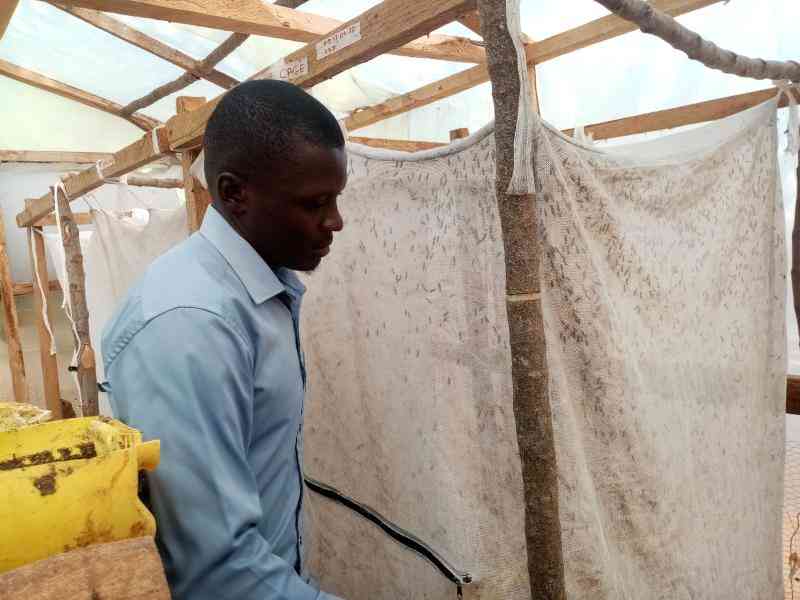By Lillian Kiarie
Kenya: Some investments do not demand land or huge capital injections — all they require is art.
Mr David Kimani, 33, is one of those people who have found a way to build a fortune from creativity.
He is in the fly tying business, which means he makes and exports artificial flies that are used to help catch fish. For his efforts, he says he earns an average Sh200,000 a month.
“Fly tying is essentially a method of securing various materials, such as feathers, fur or tinsel, to a fish hook to imitate an aquatic creatures that fish feed on. Fishing done using these artificial flies is called fly fishing,” Mr Kimani says.
Interest
He got interested in the art when he was 12 after several Sunday afternoons of following his grandfather to the river to fish, and observing him use a fly-fishing kit.
“After watching him for seven months, I made my first fly using peacock feathers. Even though the end product was poorly executed, I enjoyed the process and got interested in perfecting the craft,” Kimani says.
You do not need to be a fisherman to start fly tying, but you will need to figure out and master an orderly, step-by-step creative process, and learn the feeding habits of various fish species.
“As your experience grows, you will be exposed to different patterns and your creativity level will grow,” Kimani says.
The flies are sold in dozens and range in price from Sh172 ($2) to Sh1,290 ($15), depending on how intricate the design is.
“Your hook can be dressed with feathers or synthetic fibres. The feathers can be from turkeys, hens, quails, pheasants or peacocks,” Kimani says.
Most poultry in Kenya is bred for meat or eggs, which means fly tying offers a whole new revenue stream for savvy farmers.
There are four basic types of flies made to imitate fish prey: dry flies mimic adult insects that are about to learn how to fly; wet flies look like sprites and pupae that are swimming toward the surface of the water; nymphs represent the nymphal or larvae stage in an insect’s life cycle; and streamers represent crayfish, leaches and a variety of other life forms found in lakes and streams.
Since fish often eat these types of insects, it is important that your imitations fool them.
Stay informed. Subscribe to our newsletter
Mr Jared Momanyi, who also practices fly tying, says the basic equipment you need to get started includes: assorted feathers, furs, threads and hooks; scissors with sharp blades to cut the materials into various patterns; tying silk; a bobbin holder to make working with tying silk easier; a hackle to turn feathers around a hook; fly-tying cement to hold the bits of material together; fly-tying wax to stick the materials onto a hook; and dubbing material to get rid of any excess cement on hooks.
There are books and online resources that offer guidelines on the patterns that most resemble fish prey, and the materials that will give you the best results.
“Remember to choose the right hook so that your fly has the right proportions. If you choose the wrong hook, you’ll have a flawed fly, and you will not be successful when fishing,” Mr Momanyi says.
Since the demand for fish flies is higher in Europe, most suppliers export their creations rather than sell them locally, where prices are lower.
“The season is at its peak in Europe starting from March onwards, and that is when we get many orders,” Kimani says.
But he warns that the business comes with its challenges.
“It is sometimes difficult to get high quality material that will make good flies. Also, since many fish tying proprietors poach those talented at fly tying, it is hard to hold on to good workers in this industry.”
Kimani adds that the market has been flooded by conmen who demand flies but then fail to pay, which makes it critical to vet potential customers.
Does the art have a future?
“As long there are fish in rivers and dams, and sport fishing is encouraged in different countries, there will always be business for us. We service a sport that has a high number of participants in foreign countries,” Kimani says.
Ms Elizabeth Wanjiru, the managing director of Kenya Fish Flies, a company that manufacturers and exports fish flies, says getting customers can be difficult.
“I usually try to book three or four large customers so that I always have options should one of them fail to renew their contract with me,” she says.
Ms Wanjiru adds that getting materials and manufacturing certain flies can be very involving and expensive.
“Exporters have high expectations — they might want a hook to be made in a particular way that is time consuming, yet you don’t get the luxury of time.”
Kenya Fish Flies does not display its specific prices online, which it says is to prevent competitors undercutting the firm.
“But basically, we say that our prices range from Sh206 to Sh1,500 per dozen.”
Want more information on the companies profiled here? Email [email protected]
 The Standard Group Plc is a
multi-media organization with investments in media platforms spanning newspaper
print operations, television, radio broadcasting, digital and online services. The
Standard Group is recognized as a leading multi-media house in Kenya with a key
influence in matters of national and international interest.
The Standard Group Plc is a
multi-media organization with investments in media platforms spanning newspaper
print operations, television, radio broadcasting, digital and online services. The
Standard Group is recognized as a leading multi-media house in Kenya with a key
influence in matters of national and international interest.
 The Standard Group Plc is a
multi-media organization with investments in media platforms spanning newspaper
print operations, television, radio broadcasting, digital and online services. The
Standard Group is recognized as a leading multi-media house in Kenya with a key
influence in matters of national and international interest.
The Standard Group Plc is a
multi-media organization with investments in media platforms spanning newspaper
print operations, television, radio broadcasting, digital and online services. The
Standard Group is recognized as a leading multi-media house in Kenya with a key
influence in matters of national and international interest.










